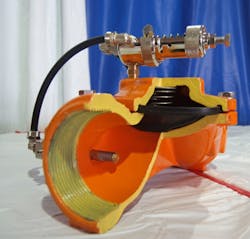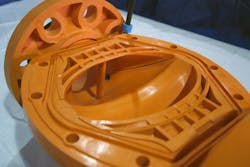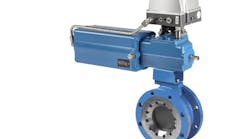Low-pressure hydraulic systems may lack the charisma of high-pressure ones – there is little drama in the thought of a pipe not bursting – but they offer unique challenges. Key among those challenges is the ability to accurately regulate low- to medium-pressure flow, especially in installations where electrical and pneumatic control hookups and SCADA systems could present a logistical or economic challenge.
A new generation of low-pressure, high-flow, hydraulic diaphragm control valves is finding its way from farmers’ fields to industrial applications to help engineers and technicians meet those challenges. In addition to precision at low pressures, the valves are bringing the no-nonsense attributes required on the farm – durability, efficiency and ease-of-maintenance.
The technology, developed in Israel to support the desert nation’s extensive network of drip irrigation systems, operates from 16 bar pressure (232 PSI) down to 0.4 bar (5.8 PSI), using line pressure to regulate the diaphragm with extreme accuracy. The result is a line of highly effective valves for a wide array of uses and environments, paving the way for a return on investment as well as a return on the environment.
“Valves designed for farm irrigation systems have to be dependable after spending all year out in the weather,” says Steve Green, a Portland, Ore.-based regional sales manager for Amiad Filtration Systems, which represents Ooval Valves in the United States and Canada. “They’ve got to be simple, reliable and easy to maintain. Farmers have so many more things to worry about than their valves. The truth is, so do facilities managers and technicians in industrial settings.”
Oval Diaphragm
Green points out that his company’s entire line of hydraulically operated automatic control valves is built around the same oval diaphragm and streamlined body design. The flexibility of the diaphragm and seal prevent grit and sediment from causing leaks, performing on-par with butterfly or gate valves with resilient seals.
Broad radii in the chamber create gentle curves that reduce cavitation, abrasion, water hammer, and noise. The design also improves Cv values up to 44 percent, nearly doubling the rate of flow compared to similarly sized conventional valves.
“The smooth flow of water through the curved chamber reduces head loss nearly 300 percent compared to conventional valves,” Green adds. “That minimizes the energy demand for pumps upstream of the valve and reduces the need for booster pumps downstream. That’s one of the things we’re talking about when we discuss ‘return on environment’ – the ability to be more productive and successful with the resources at hand.”
Another aspect of return on environment is the possibility of downsizing piping in the system because the valve is no longer a bottleneck. According to Green, this can represent a significant savings in cost and materials. He says, “Even the valves themselves are optimized so they reduce the amount of material needed in their manufacture.”
Stormwater Treatment
Broad radii in the valve chamber yields more efficient flow with less cavitation and water hammer. Line pressure governs flow pressure without electronic or pneumatic hookups.
Engineers Ayn Generes and Daniel Joseph at StormwateRx LLC in Portland, Ore., recently specified a two-inch, hydraulically operated flow control valve for their company’s Purus Metals Polishing System for stormwater treatment.
The Purus system is deployed outdoors at a wide variety of industrial sites, providing best management practices (BMPs) for stormwater treatment. Depending on site needs, the systems can be designed to remove turbidity, metals, toxic organic compounds, or bacteria in compact, self-contained, above-ground units.
Until recently, the Purus system was designed with a PVC plumbing loop to maintain a water column in the filtration media. Generes and Joseph switched to a low-pressure-sustaining valve for a compact, reliable solution to maintaining the desired water level. The valve is available in a UV-resistant nylon/fiberglass construction, a good choice for a system designed to remove metals from the water. The StormwateRx team set the valve to its lowest available pressure, about 3-5 PSI.
“The valve wouldn’t have worked for us if there wasn’t an option for that low of a pressure point setting,” says Generes. The compact valve is also easier to insulate for units that will encounter freezing conditions, she adds.
Generes says she sees potential for other low-pressure valves on StormwateRx systems. “The flowrate control valve looks like it would be a useful valve in our applications where the pressure will be increasing over time but we want to keep a constant flowrate,” she says. “We haven’t incorporated this valve into our design yet, but given how simple the pressure-sustaining valve is to use, we may be incorporating this valve in the future.”
Simplicity is Key
A great deal of the simplicity of the valves is the result of practical, on-farm experience, notes Green. He points out that the valves are designed for quick in-line inspection and maintenance. Because the body of the valve is tapped, farmers or technicians can access the chamber with a single wrench, removing four bolts rather than the typical eight to open the housing. The diaphragm has no perimeter holes, speeding re-assembly. And both metal and plastic bodies are lightweight and extremely durable, he adds.
Simplicity translates well indoors, too. At Get Fresh Sales, a leading produce company in Las Vegas, Nev., facilities manager Chris Crawford installed one of the Israeli-made pressure relief valves on his company’s antimicrobial application line. “It was just plug and play,” he says. “As long as you have a drain line to connect to, you just put in a T, put in this valve, and you’re going.”
Excessive pressure in a line spraying tomatoes can be a disaster, Crawford notes. It doesn’t take too much force for a stream of water to bruise costly tomatoes or even slice them in half. Get Fresh uses the pressure-relief valve to maintain pressure at 42 PSI, though Crawford may speed up his processing line in the future by raising pressure, adding nozzles and simply adjusting the relief valve.
Transition From the Farm
Sometimes transitioning from farm scale to industrial use requires a little adjustment. The two-inch valves common in irrigation systems are bigger than what he needs for his ¾” spray line, so Crawford and Charlie Pappas of Las Vegas Windustrial Company stepped the inlet side of the valve down to 3/8”, and the discharge side to ½” to keep a bit of backpressure on the valve. The extra plumbing was worthwhile though, says Crawford, as it allows him to tap into the hydraulic operation of the valve and forget about running more electric or electric/pneumatic lines.
“It’s like automating the system without electronics,” he says. “I don’t have to baby-sit this system. It allows me to turn the system on in the morning and not have to worry about it for the rest of the day.”
The move from agriculture to industry is a well-worn path, notes Jim Lauria, vice president of marketing and business development for Amiad Filtration Systems. “We saw the same evolution in the filtration industry, where the automatic self-cleaning filters designed by Israeli engineers to protect their high-efficiency drip irrigation systems quickly demonstrated their value in industrial and municipal settings. Today that technology has been scaled to nearly any size and spec.”




